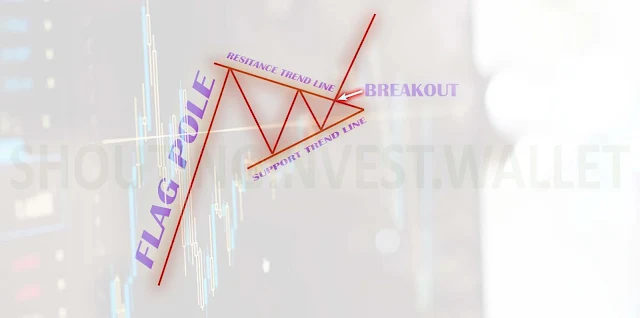What is a Bullish Pennant Pattern in Trading?
A bullish pennant is a chart pattern that appears in financial markets and is used to signal a continuation of an uptrend. The pattern is formed when the price of an asset moves in a narrow range after a rapid upward move, creating a "flag" shape on a chart. The bullish pennant is considered a bullish pattern because it indicates that the upward momentum in the market is still strong, and that prices are likely to continue rising.
How to Identify a Bullish Pennant
A bullish pennant is characterized by two distinct features: a flagpole and a pennant. The flagpole represents the initial rapid upward move in the price of an asset, while the pennant represents the subsequent period of consolidation or sideways movement.
To identify a bullish pennant, traders look for the following:
- An upward trend: The first step in identifying a bullish pennant is to look for an existing upward trend in the market. This is the initial move that creates the flagpole.
- Flagpole: The flagpole is the initial rapid upward move in the price of an asset. This move should be sharp and steep, and should occur over a relatively short period of time.
- Pennant: The pennant is the period of consolidation or sideways movement that follows the flagpole. This period should be characterized by a narrowing of the price range, with the price moving within a confined area.
- Breakout: Finally, traders look for a breakout from the pennant, which signals the continuation of the upward trend. This breakout is usually accompanied by a spike in volume, as traders and investors rush to take advantage of the move.
Trading Using the Bullish Pennant
Traders can use the bullish pennant to trade assets in a number of ways. Here are a few common strategies:
1. Buy on Breakout
One of the most straightforward strategies for trading a bullish pennant is to buy the asset when it breaks out from the pennant. This usually occurs when the price moves above the upper resistance level of the pennant, indicating a continuation of the upward trend.
2. Set a Stop Loss
To manage risk, traders should set a stop loss order just below the lower support level of the pennant. This helps to protect against potential losses in case the breakout fails and the price moves lower.
3. Take Profit
Traders can take profit at the next resistance level above the breakout point, or they can hold the position until they see signs of a trend reversal.
Example of Trading a Bullish Pennant
Let's say that the price of ABC stock has been in an upward trend, and that a bullish pennant has formed on the chart. The flagpole is formed by a rapid upward move in the price of the stock, and the pennant is formed by a period of consolidation.
At this point, a trader may decide to buy ABC stock on a breakout from the pennant, placing a stop loss order just below the lower support level of the pennant and taking profit at the next resistance level.
In this scenario, the trader would be buying the stock on the belief that the upward trend in the market will continue, and that the price of ABC stock will move higher. If the breakout is successful and the price moves higher, the trader would be able to capture some of the gains from the move.
Entering a trade using the Bullish Pennant pattern involves the following steps:
Identify the pattern:
Look for a rapid upward move in the price of an asset, followed by a period of consolidation or sideways movement in a narrow range. This creates the flagpole and the pennant that make up the Bullish Pennant pattern.
1. Buy on Breakout: Wait for the price to break out from the pennant, usually by moving above the upper resistance level. This signals a continuation of the upward trend and is a good time to buy the asset.
2. Mark Take Profit: To maximize profits, set a take profit order at the next resistance level above the breakout point. Alternatively, you can hold the position until you see signs of a trend reversal.
3. Mark Stop Loss: To manage risk, set a stop loss order just below the lower support level of the pennant. This helps to limit potential losses in case the breakout fails and the price moves lower.
Conclusion
The bullish pennant is a useful chart pattern for traders who are looking to capitalize on the continuation of an uptrend in the market. By identifying the pattern and following a few simple trading strategies, traders can
.png)











0 $type={blogger}:
Post a Comment
Found Spell Error , Need to add more content use this form to Suggest Edit